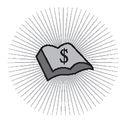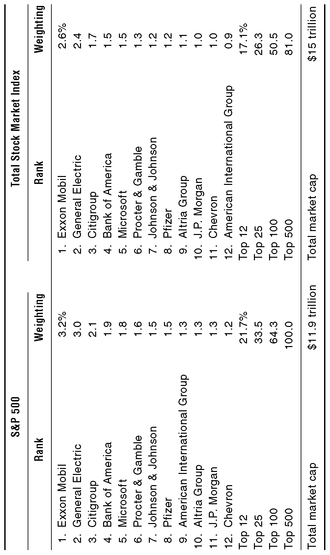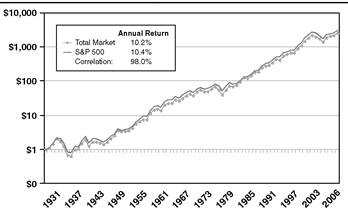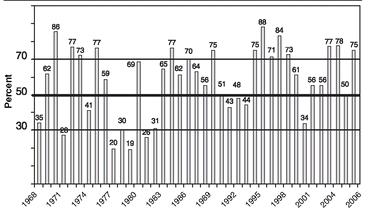Chapter Three
Cast Your Lot with Business
Rely on Occam’s Razor to Win by Keeping It Simple.
SO HOW DO YOU cast your lot with business? Simply by buying a portfolio that owns the shares of every business in the United States and then holding it forever. It is a simple concept that guarantees you will win the investment game played by most other investors who—as a group—are guaranteed to lose.
Please don’t equate simplicity with stupidity. Way back in 1320, William of Occam expressed it well, essentially setting forth this precept: When there are multiple solutions to a problem, choose the simplest one.
8 And so Occam’s Razor came to represent a major principle of scientific inquiry. By far the simplest way to own all of U.S. business is to hold the total stock market portfolio.
Occam’s Razor: When there are multiple solutions to a problem, choose the simplest one.
For most of the past 80 years, the accepted stock market portfolio was represented by the Standard & Poor’s 500 Index (the S&P 500), which was created in 1926 and now lists 500 stocks. It is essentially composed of the 500 largest U.S. corporations, weighted by the value of their market capitalizations.
9 In recent years, these 500 stocks have represented about 80 percent of the market value of all U.S. stocks. The beauty of such a cap-weighted index is that it automatically adjusts to changing stock prices and never has to buy and sell stocks for that reason.
With the enormous growth of corporate pension funds between 1950 and 1990, it was an ideal measurement standard, the benchmark or hurdle rate that would be the comparative standard for how their professional managers were performing. Today, the S&P 500 remains a valid standard against which to compare the returns earned by the professional managers of pension funds and mutual funds.
In 1970, an even more comprehensive measure of the U.S. stock market was developed. Originally called the Wilshire 5000, it is now named the Dow Jones Wilshire Total Stock Market Index. It includes some 4,971 stocks, including the 500 stocks in the S&P 500. However, because its component stocks also are weighted by their market capitalization, those remaining 4,471 stocks account for only about 20 percent of its value. Nonetheless, this broadest of all U.S. stock indexes is the best measure of the aggregate value of stocks, and therefore a superb measure of the returns earned in U.S. stocks by all investors as a group.
The two indexes have a similar composition.
Exhibit 3.1 shows the 12 largest stocks in each, and their weight in the construction of each index.
Given the similarity of these two portfolios, it is hardly surprising that the two indexes have earned returns that are in lockstep with one another. The Center for Research in Security Prices at the University of Chicago has gone back to 1926 and calculated the returns earned by all U.S. stocks. (Its data since 1970 have provided a virtually perfect match to the Total Stock Market Index.) In fact, returns of the two indexes parallel one another with near precision. From 1928, the beginning of the measurement period, through 2006, you can hardly tell them apart (
Exhibit 3.2).
EXHIBIT 3.1 S&p 500 versus Total Stock Market Index: Portfolio Comparison, July 2006
For the full period, the average annual return on the S&P 500 was 10.4 percent; the return on the Total Stock Market Index was 10.2 percent. This represents what we call a period dependent outcome—everything depends on the starting date and the ending date. If we were to begin the comparison at the beginning of 1930 instead of 1926, the returns of the two would be identical: 9.9 percent per year.
Yes, there are variations over the interim periods: the S&P 500 was much the stronger from 1982 to 1990, when its annual return of 15.6 percent outpaced the Total Stock Market Index return of 14.0 percent. But in recent years (1998 to 2006), small- and mid-cap stocks did better, and the Total Stock Market Index return of 3.4 percent per year nicely exceeded the 2.4 percent return of the S&P 500. But with a long-term correlation of 0.98 between the returns of the two indexes (1.0 is perfect correlation), there is little to choose between them.
Whichever measure we use, it should now be obvious that the returns earned by the publicly held corporations that compose the stock market must of necessity equal the aggregate gross returns earned by all investors in that market as a group. Equally obvious, as discussed in Chapter 4, the net returns earned by these investors must of necessity fall short of those aggregate gross returns by the amount of intermediation costs they incur. Our common sense tells us the obvious; while owning the stock market over the long term is a winner’s game, beating the stock market is a loser’s game.
If the data do not prove that indexing wins, well, the data are wrong.
Such an all-market fund is guaranteed to outpace over time the returns earned by equity investors as a group. Once you recognize this fact, you can see that the index fund is guaranteed to win not only over time, but every year, and every month and week, even every minute of the day. Because no matter how long or short the time frame, the gross return in the stock market, minus intermediation costs, equals the net return earned by investors as a group. If the data do not prove that indexing wins, well, the data are wrong.
Over the short term, however, it doesn’t always look as if the S&P 500 (still the most common basis of comparison for mutual funds and pension plans) or the Total Stock Market Index is winning. That is because there is no possible way to calculate the returns earned by the millions of diverse participants, amateur and professional alike, Americans and foreign investors, in the U.S. stock market.
So what we do in the mutual fund field is calculate the returns of the various funds, counting each fund—instead of each fund’s assets—as one entry. Since there are many small-cap and mid-cap funds, usually with relatively modest asset bases, they make a disproportionate impact on the data. When small- and mid-cap funds are leading the total market, the all-market index fund seems to lag. When small- and mid-cap stocks are lagging the market, the index fund looks formidable indeed.
Nonetheless, the exercise of calculating how the returns earned by the stock market compare with returns earned by the average equity fund is both illuminating and persuasive (
Exhibit 3.3). If we compare the results of what are described as “large-cap core” funds with the returns of the S&P 500 (because of its market capitalization weightings, a “large-cap core” index), the advantage of the S&P Index is impressive.
EXHIBIT 3.3 Large-Cap Core Funds Outperformed by S&P 500
During the 39-year period 1968 to 2006, the S&P 500 fell into the bottom quartile in only two years (and has not done so since 1979). The Index has outpaced the average fund in 26 of the remaining 35 years, including 11 of the past 15 years. Its average ranking was in the 58th percentile (outperforming 58 percent of the comparable actively managed funds), leading, as we will show in Chapter 4, to enormous superiority over time. It is hard to imagine that even a single one of the large-cap core equity funds has a similar record of consistency.
Consistency matters. A fund that is good or very good in the vast majority of years produces a far larger long-term return than a fund that is superb in half the years and a disaster in the remaining half. Single-year rankings, then, ignore the sheer arithmetic advantage of that consistency. In the next chapter, the impact of that long-term consistency is catalogued over the past 25 years.
These annual data are what we call survivor-biased; they exclude the records of the inevitably poorer performing funds that regularly go out of business. As a result of this noise in the data, the chart further understates the success of the market-owning index strategy.
Much criticism has been heaped on the S&P 500 for often picking “new economy” stocks such as JDS Uniphase and Yahoo! near their inflated peak prices during the bubble, just before they crashed, thereby taking on a growth bias at exactly the wrong time. While the criticism is valid, the excellent long-term record of the flawed Index belies the existence of a significant problem. In fact, since the market peaked early in 2000 (as shown in
Exhibit 3.3), the S&P 500 has had only a single significantly subpar year (2000), three years at about par, and three years (2003, 2004, and 2006) in the top quartile of its peers. I imagine that the vast majority of money managers would have been ecstatic with such an outcome.
The record of the first index mutual fund: $15,000 invested in 1976; value in 2006, $461,771.
Thus, the recent era not only has failed to erode, but has nicely enhanced the lifetime record of the world’s first index fund—now known as Vanguard 500 Index Fund. Let me be specific: at a dinner on September 20, 2006, celebrating the 30th anniversary of the fund’s initial public offering, the counsel for the fund’s underwriters reported that he had purchased 1,000 shares at the original offering price of $15.00 per share—a $15,000 investment. He proudly announced that the value of his holding that evening (including shares acquired through reinvesting the fund’s dividends and distributions over the years) was $461,771. Now, there’s a number that requires no comment.
10This cumulative long-term winning record confirms that owning American business through a broadly diversified index fund is not only logical but, to say the least, incredibly productive. Equally important, it is consistent with the age-old principle expressed by Sir William of Occam: instead of joining the crowd of investors who dabble in complex machinations to pick stocks and try to outguess the stock market (two inevitably fruitless tasks for investors in the aggregate), choose the simplest of all solutions—buy and hold the market portfolio.
Don’t Take My Word for It
Hear David Swensen, widely respected chief investment officer of the Yale University Endowment Fund. “A minuscule 4 percent of funds produce market-beating after-tax results with a scant 0.6 percent (annual) margin of gain. The 96 percent of funds that fail to meet or beat the Vanguard 500 Index Fund lose by a wealth-destroying margin of 4.8 percent per annum.”
The simple index fund solution has been adopted as a cornerstone of investment strategy for many of the nation’s pension plans operated by our giant corporations and state and local governments. Indexing is also the predominant strategy for the largest of them all, the retirement plan for federal government employees, the Federal Thrift Savings Plan (TSP). The plan has been a remarkable success, and now holds some $173 billion of assets for the benefit of our public servants and members of armed services. All contributions and earnings are tax-deferred until withdrawal, much like the corporate 401(k) thrift plans. (Overcoming what must have been some serious reservations, even the Bush administration determined to follow the TSP model in its plan for Personal Savings Accounts as an optional alternative to our Social Security program.)
Indexing is also praised across the Atlantic “pond.” Listen to these words from Jonathan Davis, columnist for London’s The Spectator: “Nothing highlights better the continuing gap between rhetoric and substance in British financial services than the failure of providers here to emulate Jack Bogle’s index fund success in the United States. Every professional in the City knows that index funds should be core building blocks in any long-term investor’s portfolio. Since 1976, the Vanguard index fund has produced a compound annual return of 12 percent, better than three-quarters of its peer group. Yet even 30 years on, ignorance and professional omerta still stand in the way of more investors enjoying the fruits of this unsung hero of the investment world.”








